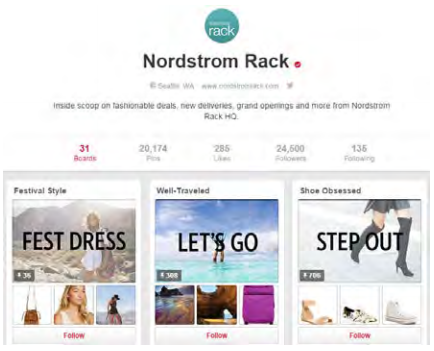16.7: Pinterest
- Page ID
- 42271

Introduction and stats
Pinterest started in 2010. It is classified as a visual bookmarking site, where users can ‘pin’, categorise and share images and ideas they find online. Despite being pitched as a catalogue of ideas rather than a social networking platform, the site is considered one of the most popular social media websites with over 100 million active monthly users (Rouse and Wigmore, 2016).

Features
Each pin is an idea. This could be a recipe, an image, an article, or a quote. Each pin links back to its original site. By including the Save button (or Pin It) button to your site, you make it easier for users to pin your content onto their boards in Pinterest.
Pinterest’s main feature is the board. You create ‘boards’ on your profile by posting content or pinning content you find online. You can also repin content from other users’ boards. Boards need to be designed and crafted around themes, and each board should be uniquely named. Users can follow a board or a profile. Boards are classified under subject categories, which help users find what they are interested in.

You can now shop directly on Pinterest from a selected group of retail partners within the US. This will be extended to other retailers. Users browse pins as normal, and when viewing a buyable pin an “Add to bag” button will appear. The “Add to bag” button links back to the merchant’s store, enabling the user to purchase on Pinterest, with all necessary order details and payment information sent directly to the merchant for processing. To find out more about buying products on Pinterest, visit https://help.pinterest.com/en/articl...g-on-pinterest.
Marketing and advertising on Pinterest
As a business, you can create your own business page. This includes a host of tools, such as:
- Analytics
- Direct links back to your website
- Easier pinning of your website content via the save button
- Newsletters
- Buyable pins
- Options for promoting material
Even widget builders. Business profiles should not only be providing boards of their products. Boards should include the lifestyle or essence behind the brand. A makeup brand, for example, could also include boards on high fashion, new trends in makeup, interesting use of makeup in movies, and even general skin care.
Rich Pins allow businesses to add extra details to their Pins, such as the ability to:
- Directly install an app
- Include location and contact information
- Connect to articles
- Link to product information and purchase details
- Include recipes
- Show ratings and reviews for the latest movies.
To see more about using Pinterest for marketing and advertising, see business.pinterest. com/en/tools and www. forbes.com/sites/ ajagrawal/2016/03/15/ top-tips-forbeing-successfulon-pinterest-in2016/2/#3d8b49317df1 as well as the Social media advertising chapter
Promoted pins are pins that the business pays for to reach more people. They’re native ad units that help users discover and save your ideas. Promoted pins work for awareness, engagement and directing traffic to your website. Pinterest has also introduced buyable pins, which allow users to buy your products directly through Pinterest.
Pinterest Analytics
Pinterest Analytics is the native analytics tool built into the site. It is available automatically to business account holders. It provides information on some important metrics, including:
- The most repinned items on your boards
- Various metrics about your audience, including their interests and the types of things they want to repin
- Impressions and viewers.
It gives information about what is working and not working on your boards, which can be adjusted accordingly. This should inform strategy and board design going forward (Pinterest, 2016).
Pinterest summary
The visual nature of Pinterest and the ability to use boards as collections make the platform a good choice for retail brands. Brands that target women are likely to do well on the platform due to its strong female demographic. Marketers who have used Pinterest comment on its higher than average conversion rate, with some attributing it to the fact that users of the platform are further along in the buying cycle. Pinterest is gaining in popularity as a social media space for marketing, and should not be written off when considering platforms.


